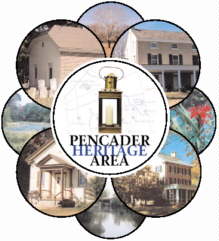 Ott's Chapel, located on the West side of Ott's Chapel Road, just north of Sandy Brae, is the legacy of Stephan Ott, his wife Jane, and
a small group of faithful parishioners dedicated to a cause. Incorporated in 1887, the building sits on one half acre of land which the trustees finally purchased in 1930, for the grand sum of five dollars. The deed lists five trustees whose families were prominent in the Iron Hill area: Mamie Schwartz, Bertha P. Wood, Mary F. Leal, Mary E. Rambo and Charles F. Walton. Formerly known as the Campbellites, the religious
denomination was changed to The Christian Church at Chestnut Hill, and from the little chapel on the hill they launched a serious campaign against 'spiritous liquors'.
Ott's Chapel, located on the West side of Ott's Chapel Road, just north of Sandy Brae, is the legacy of Stephan Ott, his wife Jane, and
a small group of faithful parishioners dedicated to a cause. Incorporated in 1887, the building sits on one half acre of land which the trustees finally purchased in 1930, for the grand sum of five dollars. The deed lists five trustees whose families were prominent in the Iron Hill area: Mamie Schwartz, Bertha P. Wood, Mary F. Leal, Mary E. Rambo and Charles F. Walton. Formerly known as the Campbellites, the religious
denomination was changed to The Christian Church at Chestnut Hill, and from the little chapel on the hill they launched a serious campaign against 'spiritous liquors'.
The first of the Ott family to come to America was Andrew Ott, who was born in Germany and settled in Philadelphia County, Pa. before the Revolution. He served as aide-de-camp to General Washington and according to J. M. Runk's, History of Delaware, written in 1899, 'He suffered the same privations that made the fight for freedom so sore a trial for the soldiers of the file, and his enforced diet of black snake's flesh at one time during the war, to save himself from starvation, tells how enormous was the distress of the gallant Continental army.'
Evidently the diet of snake flesh was not too detrimental to his health for he lived to be one hundred and two years old. Of his several children, one was named Leonard Ott; he married twice and fathered nine children, one of whom was Stephan, born in Philadelphia County in 1818.
A brick and stone mason by trade, Stephan moved to Pencader Hundred in 1852, and for $2,200 purchased 134 acres of land from
Ferguson Maney. (Ferguson was one of many of that day unable to read or write and the deed is signed with an X.) To this land he added 140 acres in 1859 at a cost of $6,000. In 1864, he added 50 more acres, paying $1,100 dollars for land along the railroad at the Maryland State line, with the 'privilege to pile wood and timber at the side track now laid in the field adjoining said railroad.' He cleared the land and quickly discovered how well fruit grew in the Iron Hill soil. According to J. M. Runk, he was the first man to sell a wagonload of strawberries in the Wilmington markets.
Stephan Ott soon discovered his calling as a preacher and was instrumental in leading the movement to erect a chapel for worship in his section of Pencader Hundred. Preaching with a missionary zeal without pay, he donated his services and monetary support to fight for the temperance cause. For twenty-five years he was president and spiritual advisor of a neighborhood temperance society, with his wife Jane by his side. Of their five children four survived and two of the girls married into local families by the names of Ash and Walton, a characteristic of rural
areas where close family ties are often formed through marriage within a small community.
Stephan and Jane Ott are interred together behind the chapel, their graves marked by a unique double tombstone, inscribed:
Elder Stephan Ott, 1818-1875 and Jane Ott, 1817-1881
Active earnest faithful in their united effort
for the advancement of Christ's cause
They were not long separated in death
|
